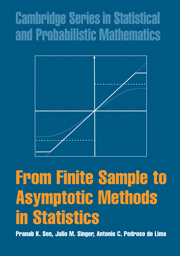Book contents
- Frontmatter
- Contents
- Preface
- 1 Motivation and Basic Tools
- 2 Estimation Theory
- 3 Hypothesis Testing
- 4 Elements of Statistical Decision Theory
- 5 Stochastic Processes: An Overview
- 6 Stochastic Convergence and Probability Inequalities
- 7 Asymptotic Distributions
- 8 Asymptotic Behavior of Estimators and Tests
- 9 Categorical Data Models
- 10 Regression Models
- 11 Weak Convergence and Gaussian Processes
- Bibliography
- Index
4 - Elements of Statistical Decision Theory
Published online by Cambridge University Press: 05 June 2012
- Frontmatter
- Contents
- Preface
- 1 Motivation and Basic Tools
- 2 Estimation Theory
- 3 Hypothesis Testing
- 4 Elements of Statistical Decision Theory
- 5 Stochastic Processes: An Overview
- 6 Stochastic Convergence and Probability Inequalities
- 7 Asymptotic Distributions
- 8 Asymptotic Behavior of Estimators and Tests
- 9 Categorical Data Models
- 10 Regression Models
- 11 Weak Convergence and Gaussian Processes
- Bibliography
- Index
Summary
Introduction
Statistical estimation as well as hypothesis testing may be viewed as important topics of a more general (and admittedly, more abstract) statistical decision theory (SDT). Having genesis in the theory of games and affinity with Bayes methods, SDT has been continuously fortified with sophisticated mathematical tools as well as with philosophical justifications. In conformity with the general objectives and contended intermediate level of this monograph, we intend to provide an overall introduction to the general principles of SDT with some emphasis on Bayes methodology (as well as some of its variants), avoiding the usual philosophical deliberations and mathematical sophistication, to the extent possible. See Berger (1993) for a detailed exposition.
The connection between estimation and hypothesis testing theories treated in the preceding chapters and SDT relates to the uncertainty of statistical conclusions or decisions based on observed data sets and to the adequate provision for quantifying the frequency of incorrect ones. This has generated the notion of loss and risk functions that form the foundation of SDT. This notion serves as a building block for the formulation of minimum risk and minimax (risk) estimation theory, where Bayes estimates have a focal stand. In the same vein, Bayes tests, which are not necessarily isomorphic to the Neyman–Pearson–Wald likelihood-based tests have cropped up in SDT. In either case, the basic difference comes from the concepts of prior and posterior distributions that bring in more room for subjective judgement in the inferential process.
- Type
- Chapter
- Information
- From Finite Sample to Asymptotic Methods in Statistics , pp. 83 - 99Publisher: Cambridge University PressPrint publication year: 2009

